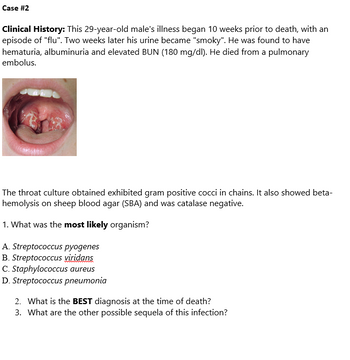
Phlebotomy Essentials
6th Edition
ISBN: 9781451194524
Author: Ruth McCall, Cathee M. Tankersley MT(ASCP)
Publisher: JONES+BARTLETT PUBLISHERS, INC.
expand_more
expand_more
format_list_bulleted
Question

Transcribed Image Text:Case #2
Clinical History: This 29-year-old male's illness began 10 weeks prior to death, with an
episode of "flu". Two weeks later his urine became "smoky". He was found to have
hematuria, albuminuria and elevated BUN (180 mg/dl). He died from a pulmonary
embolus.
The throat culture obtained exhibited gram positive cocci in chains. It also showed beta-
hemolysis on sheep blood agar (SBA) and was catalase negative.
1. What was the most likely organism?
A. Streptococcus pyogenes
B. Streptococcus viridans
C. Staphylococcus aureus
D. Streptococcus pneumonia
2. What is the BEST diagnosis at the time of death?
3. What are the other possible sequela of this infection?
Expert Solution
This question has been solved!
Explore an expertly crafted, step-by-step solution for a thorough understanding of key concepts.
This is a popular solution
Trending nowThis is a popular solution!
Step by stepSolved in 5 steps

Knowledge Booster
Similar questions
- What condition do you suspect with this patient? Young man who uses a wheelchair and has trouble breathing. Furhter assessments reveals coarse rhonci in all fields with a pulse ox at 84%, Pale and greasy stool. A) Lung cancer B) Poliomyelitis C) Cystic Fibrosis D) Nyasthenia gravisarrow_forwardInterpret the following casesCase a. A patient came to the hospital with a runny nose, and flu-like symptoms. After checkup the doctor ordered Differential WBC test and the results were 65% N., 15% E. and, 19% L. what does the patient have and why?Case b. A patient came to the clinic with fever, loss of appetite and abdominal pain. The lab results came out to be 72% Neutrophil, 4% M, 24% L. what does the patient have and why? Talk generallyarrow_forwardA solution containing 500,000 units of polymyxin B sulfate in 10 mL of sterile water for injection is added to 250 mL of D5W to make a total volume of 260 mL. The infusion is to be administered over 2 hours. If the administration set delivers 10 drops/mL, at what rate, in drops per minute, should the infusion be given to ensure the patient receives the dose within the designated time interval?arrow_forward
- Answer choices are on second picarrow_forwardCan I have both questions answeredarrow_forwardCase Study #6: A 20 year old male college student develops a fever after gall bladder surgery and has a pus exudate around the incision. You receive a cotton swab of the exudate which you streak on a blood agar plate. Bacterial colonies on the plate show B hemolysis, and microscopic examination reveals Gram + cocci occurring singly, in pairs, and in short chains. Further testing reveals that the isolate is catalase negative and phenol red fermentation broth with mannitol turns yellow. 1. What is the name of the most likely bacterium causing this infection? 2. What is the most likely place that this bacterium originated to cause this infection?arrow_forward
arrow_back_ios
arrow_forward_ios
Recommended textbooks for you
 Phlebotomy EssentialsNursingISBN:9781451194524Author:Ruth McCall, Cathee M. Tankersley MT(ASCP)Publisher:JONES+BARTLETT PUBLISHERS, INC.
Phlebotomy EssentialsNursingISBN:9781451194524Author:Ruth McCall, Cathee M. Tankersley MT(ASCP)Publisher:JONES+BARTLETT PUBLISHERS, INC. Gould's Pathophysiology for the Health Profession...NursingISBN:9780323414425Author:Robert J Hubert BSPublisher:Saunders
Gould's Pathophysiology for the Health Profession...NursingISBN:9780323414425Author:Robert J Hubert BSPublisher:Saunders Fundamentals Of NursingNursingISBN:9781496362179Author:Taylor, Carol (carol R.), LYNN, Pamela (pamela Barbara), Bartlett, Jennifer L.Publisher:Wolters Kluwer,
Fundamentals Of NursingNursingISBN:9781496362179Author:Taylor, Carol (carol R.), LYNN, Pamela (pamela Barbara), Bartlett, Jennifer L.Publisher:Wolters Kluwer, Fundamentals of Nursing, 9eNursingISBN:9780323327404Author:Patricia A. Potter RN MSN PhD FAAN, Anne Griffin Perry RN EdD FAAN, Patricia Stockert RN BSN MS PhD, Amy Hall RN BSN MS PhD CNEPublisher:Elsevier Science
Fundamentals of Nursing, 9eNursingISBN:9780323327404Author:Patricia A. Potter RN MSN PhD FAAN, Anne Griffin Perry RN EdD FAAN, Patricia Stockert RN BSN MS PhD, Amy Hall RN BSN MS PhD CNEPublisher:Elsevier Science Study Guide for Gould's Pathophysiology for the H...NursingISBN:9780323414142Author:Hubert BS, Robert J; VanMeter PhD, Karin C.Publisher:Saunders
Study Guide for Gould's Pathophysiology for the H...NursingISBN:9780323414142Author:Hubert BS, Robert J; VanMeter PhD, Karin C.Publisher:Saunders Issues and Ethics in the Helping Professions (Min...NursingISBN:9781337406291Author:Gerald Corey, Marianne Schneider Corey, Cindy CoreyPublisher:Cengage Learning
Issues and Ethics in the Helping Professions (Min...NursingISBN:9781337406291Author:Gerald Corey, Marianne Schneider Corey, Cindy CoreyPublisher:Cengage Learning

Phlebotomy Essentials
Nursing
ISBN:9781451194524
Author:Ruth McCall, Cathee M. Tankersley MT(ASCP)
Publisher:JONES+BARTLETT PUBLISHERS, INC.

Gould's Pathophysiology for the Health Profession...
Nursing
ISBN:9780323414425
Author:Robert J Hubert BS
Publisher:Saunders

Fundamentals Of Nursing
Nursing
ISBN:9781496362179
Author:Taylor, Carol (carol R.), LYNN, Pamela (pamela Barbara), Bartlett, Jennifer L.
Publisher:Wolters Kluwer,

Fundamentals of Nursing, 9e
Nursing
ISBN:9780323327404
Author:Patricia A. Potter RN MSN PhD FAAN, Anne Griffin Perry RN EdD FAAN, Patricia Stockert RN BSN MS PhD, Amy Hall RN BSN MS PhD CNE
Publisher:Elsevier Science

Study Guide for Gould's Pathophysiology for the H...
Nursing
ISBN:9780323414142
Author:Hubert BS, Robert J; VanMeter PhD, Karin C.
Publisher:Saunders

Issues and Ethics in the Helping Professions (Min...
Nursing
ISBN:9781337406291
Author:Gerald Corey, Marianne Schneider Corey, Cindy Corey
Publisher:Cengage Learning